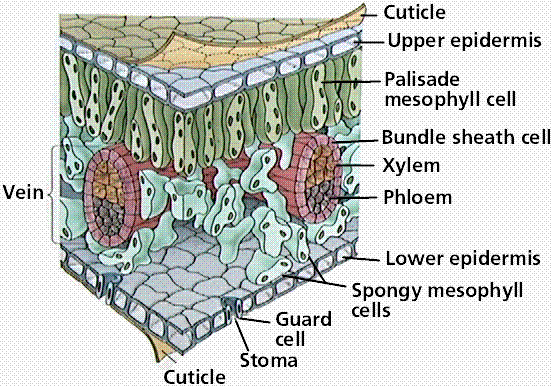


Flower
POWER
Structure of a Leaf
Leaves are a major location of photosynthesis. Their green color comes from chlorophyll, a green pigment within chloroplasts.
Leaves have many different layers that are not visible by the naked eye.
The Epidermis is the outer layer of tissues. The cuticle is located on the upper epidermis (and on the lower but mainly the upper) and is a waxy protective outer layer that prevents water loss on leaves. The amount of cutin or wax increases with light intensity. What this means is that if there is a plant in the desert, where there is a stronger light intensity, than it will have more wax or cutin compared to a leaf in a tropical rainforest where the light intensity is weaker. The plant in the desert will need to be able to hold more water due to high rate of evaporation or lack of water source (thus needing more wax) compared to the plant in the tropical forest where light may not be constantly hitting the leaf and water loss is not as abundant. Also located on the epidermis of the leaf are leaf hairs. The leaf hairs create a deeper boundary layer of nonmoving air trapping water vapor near the surface to create humidity. Each hair applies friction and space for still air. The humidity slows the rate of vapor loss from the stomata. The hairs also shade the surface lowering the internal temperature.
The palisade layer of the leaf is located directly below the upper epidermis. The palisade layer is a tightly packed layer of parenchyma tissues filled with chloroplasts for photosynthesis. Chloroplasts capture energy in light and begins the transformation of that energy into sugars.
This is also where mesophyll cells are located. Mesophyll cells are specialized for photosynthesis. These cells in the middle of the leaf contain many chloroplasts. Gas exchange (oxygen and carbon dioxide) take place within the chloroplasts, and the food produced by the chloroplasts must move out of the cells to other parts of the plants. The mesophyll cell is also where most chloroplasts are found. They contain about 30 to 40 chloroplasts each.
The Vascular Bundle are also located within the leaf. They are the leaf veins made out of Xylem and Phloem tissues. The area surrounding the Xylem and Phloem are often called bundle sheath cells.
Spongy Mesophyll can also be found in a leaf. These tissues loosely arrange to facilitate the movement of oxygen, carbon dioxide, and water vapor. They also may contain a few chloroplasts.
The stomata are natural (microscopic) openings on the lower epidermis of a leaf that allow for gas exchange (water vapor, carbon dioxide, and oxygen). CO2 and O2 exit and enter from the leaf through the stomata.
Gaurd cells are specialized kidney shaped cells that open and close the stomata.
